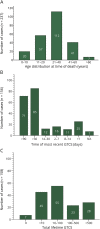SUDEP in the North American SUDEP Registry: The full spectrum of epilepsies
- PMID: 31217259
- PMCID: PMC6656646
- DOI: 10.1212/WNL.0000000000007778
SUDEP in the North American SUDEP Registry: The full spectrum of epilepsies
Abstract
Objective: To obtain medical records, family interviews, and death-related reports of sudden unexpected death in epilepsy (SUDEP) cases to better understand SUDEP.
Methods: All cases referred to the North American SUDEP Registry (NASR) between October 2011 and June 2018 were reviewed; cause of death was determined by consensus review. Available medical records, death scene investigation reports, autopsy reports, and next-of-kin interviews were reviewed for all cases of SUDEP. Seizure type, EEG, MRI, and SUDEP classification were adjudicated by 2 epileptologists.
Results: There were 237 definite and probable cases of SUDEP among 530 NASR participants. SUDEP decedents had a median age of 26 (range 1-70) years at death, and 38% were female. In 143 with sufficient information, 40% had generalized and 60% had focal epilepsy. SUDEP affected the full spectrum of epilepsies, from benign epilepsy with centrotemporal spikes (n = 3, 1%) to intractable epileptic encephalopathies (n = 27, 11%). Most (93%) SUDEPs were unwitnessed; 70% occurred during apparent sleep; and 69% of patients were prone. Only 37% of cases of SUDEP took their last dose of antiseizure medications (ASMs). Reported lifetime generalized tonic-clonic seizures (GTCS) were <10 in 33% and 0 in 4%.
Conclusions: NASR participants commonly have clinical features that have been previously been associated with SUDEP risk such as young adult age, ASM nonadherence, and frequent GTCS. However, a sizeable minority of SUDEP occurred in patients thought to be treatment responsive or to have benign epilepsies. These results emphasize the importance of SUDEP education across the spectrum of epilepsy severities. We aim to make NASR data and biospecimens available for researchers to advance SUDEP understanding and prevention.
Copyright © 2019 The Author(s). Published by Wolters Kluwer Health, Inc. on behalf of the American Academy of Neurology.
Figures


Comment in
-
SUDEP: Let's talk about it.Neurology. 2019 Jul 16;93(3):93-94. doi: 10.1212/WNL.0000000000007771. Epub 2019 Jun 19. Neurology. 2019. PMID: 31217260 No abstract available.
Similar articles
-
Genetic generalized and focal epilepsy prevalence in the North American SUDEP Registry.Neurology. 2020 Apr 21;94(16):e1757-e1763. doi: 10.1212/WNL.0000000000009295. Epub 2020 Mar 26. Neurology. 2020. PMID: 32217773 Free PMC article.
-
Sudden Unexpected Death in Epilepsy Among Patients With Benign Childhood Epilepsy With Centrotemporal Spikes.JAMA Neurol. 2017 Jun 1;74(6):645-649. doi: 10.1001/jamaneurol.2016.6126. JAMA Neurol. 2017. PMID: 28384699 Free PMC article.
-
Assessment of antiseizure medication adherence based on postmortem toxicology and claimed prescriptions in cases of sudden unexpected death in epilepsy.Epilepsia. 2025 Jun;66(6):1933-1944. doi: 10.1111/epi.18354. Epub 2025 Apr 2. Epilepsia. 2025. PMID: 40171887 Free PMC article.
-
Sudden unexpected death in epilepsy (SUDEP) in New Zealand; a retrospective review.N Z Med J. 2020 Jan 17;133(1508):65-71. N Z Med J. 2020. PMID: 31945043 Review.
-
Prevention of sudden unexpected death in epilepsy: current status and future perspectives.Expert Rev Neurother. 2020 May;20(5):497-508. doi: 10.1080/14737175.2020.1754195. Epub 2020 Apr 26. Expert Rev Neurother. 2020. PMID: 32270723 Review.
Cited by
-
Autonomic dysfunction in epilepsy mouse models with implications for SUDEP research.Front Neurol. 2023 Jan 6;13:1040648. doi: 10.3389/fneur.2022.1040648. eCollection 2022. Front Neurol. 2023. PMID: 36686527 Free PMC article. Review.
-
Seizure Susceptibility Prediction in Uncontrolled Epilepsy.Front Neurol. 2021 Sep 13;12:721491. doi: 10.3389/fneur.2021.721491. eCollection 2021. Front Neurol. 2021. PMID: 34589049 Free PMC article.
-
[SUDEP in brief - knowledge and practice recommendations on sudden unexpected death in epilepsy].Nervenarzt. 2021 Aug;92(8):809-815. doi: 10.1007/s00115-021-01075-3. Epub 2021 Feb 16. Nervenarzt. 2021. PMID: 33591415 Free PMC article. Review. German.
-
High density probes reveal medullary seizure and rapid medullary shutdown in a model of fatal apnea in seizure.bioRxiv [Preprint]. 2025 Feb 13:2025.02.10.637524. doi: 10.1101/2025.02.10.637524. bioRxiv. 2025. PMID: 39990313 Free PMC article. Preprint.
-
5-HT receptors exert differential effects on seizure-induced respiratory arrest in DBA/1 mice.PLoS One. 2024 May 31;19(5):e0304601. doi: 10.1371/journal.pone.0304601. eCollection 2024. PLoS One. 2024. PMID: 38820310 Free PMC article.
References
-
- Nashef L, So E, Ryvlin P, Tomson T. Unifying the definitions of sudden unexpected death in epilepsy. Epilepsia 2011;53:227–233. - PubMed
-
- Sveinsson O, Andersson T, Carlsson S, Tomson T. The incidence of SUDEP: a nationwide population-based cohort study. Neurology 2017;89:170–177. - PubMed
-
- Thurman DJ, Hesdorffer DC, French JA. Sudden unexpected death in epilepsy: assessing the public health burden. Epilepsia 2014;55:1479–1485. - PubMed
-
- Donner E, Smith C, Snead O. Sudden unexplained death in children with epilepsy. Neurology 2011;57:430–434. - PubMed
Publication types
MeSH terms
Substances
LinkOut - more resources
Full Text Sources
Other Literature Sources
